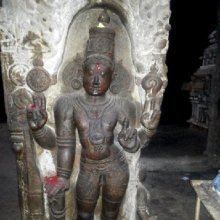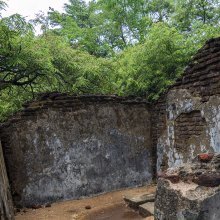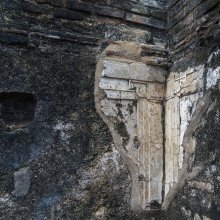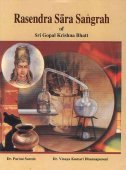Prasada, Prāsāda, Prasāda: 49 definitions
Introduction:
Prasada means something in Buddhism, Pali, Hinduism, Sanskrit, the history of ancient India, Marathi, Hindi. If you want to know the exact meaning, history, etymology or English translation of this term then check out the descriptions on this page. Add your comment or reference to a book if you want to contribute to this summary article.
Images (photo gallery)
(+3 more images available)
In Hinduism
Ayurveda (science of life)
Source: Wisdom Library: Āyurveda and botanyPrasāda (प्रसाद) refers to “essence”.
Source: gurumukhi.ru: Ayurveda glossary of terms1) Prasāda (प्रसाद):—Nutrient portion formed during various processes of biotransformation.
2) [prasādaḥ] Beneficence:

Āyurveda (आयुर्वेद, ayurveda) is a branch of Indian science dealing with medicine, herbalism, taxology, anatomy, surgery, alchemy and related topics. Traditional practice of Āyurveda in ancient India dates back to at least the first millenium BC. Literature is commonly written in Sanskrit using various poetic metres.
Vastushastra (architecture)
Source: Wisdom Library: Vāstu-śāstra1) Prāsāda (प्रासाद) is a Sanskrit technical term denoting a “residence” in general, according to the lists of synonyms given in the Mayamata XIX.10-12 and the Mānasāra XIX.108-12, both populair treatises on Vāstuśāstra literature.
2) Prāsāda (प्रासाद) is a Sanskrit technical term roughly corresponding to “temple”. It represents the dwelling place, or a residence of God. The Samarāṅgaṇasūtradhāra (chapter 49) mentions 64 types of Prāsāda classified under 5 different Vimānas, which represent the aerial cars of the Gods (but also refers to ‘palace’).
The names of the 24 Prāsādas of the Vairāja type (square shaped) of Vimāna are:
- Rucaka,
- Citrakūṭa,
- Siṃhapañjara,
- Bhadra,
- Śrīkūṭa,
- Uṣṇīṣa,
- Śālākṣa,
- Gajayūthapa,
- Nandyāvartta,
- Avataṃsāhva,
- Svastika,
- Kṣitibhūṣaṇa,
- Bhūjaya,
- Vijaya,
- Nandī,
- Śrītaru,
- Pramadāpriya,
- Vyāmiśra,
- Hastijātīya,
- Kubera,
- Vasudhadhara,
- Sarvabhadra,
- Vimāna,
- Muktakoṇa.
Then follow the names of 4x10 groups of Prāsādas for the Kailāśa (globular), Puṣpaka (square and rectangular or oblong), Maṇika (globular and oblong) and Triviṣṭapa (octangular) type of Vimānas:
- Valaya,
- Dundubhi,
- Prānta,
- Padma,
- Kānta,
- Caturmukha,
- Māṇḍuka,
- Kūrma,
- Tāligṛha,
- Ulūpika.
- Bhava,
- Viśāla,
- Sāmmukhya,
- Prabhava,
- Śivirāgṛha,
- Mukhaśāla,
- Dviśāla,
- Gṛharāja,
- Amala,
- Vibhu.
- Āmoda,
- Raitika,
- Tuṅga,
- Cāru,
- Bhūti,
- Niṣevaka,
- Sadāniṣedha,
- Siṃhākhya,
- Suprabha,
- Locanotsava
- Vajraka,
- Nandana,
- Śaṅku,
- Mekhala,
- Vāmana,
- Laya,
- Mahāpadma,
- Haṃsa,
- Vyomacandra,
- Udaya.
Thus totalling to 64 different types of Prāsāda.
Source: Shodhganga: Development of temple architecture in Southern KarnatakaPrāsāda is defined as the upper storey or storeys of any building. It may be of a temple or a palace or a house. In the context of temple architecture, prāsāda refers to the upper storeys or the tower built above the sanctum or the gateway.
Source: Digital Library of India: Bharatiya Vastu-sastra volume 1Prāsāda (प्रासाद):—The word “Prāsāda” has been used to denote temple througout the work. The name Prāsāda has the widest application. The word is unique in this respect that it does not mean a house or something that is uilt like Devāgāra or Vimāna respectively. “It denotes a settling down (pra-sad) and a seat made of that which has settled down and aqcuired concrete form, the form of a dwelling, a residence, the seat of God”. Thus our Śilpa-śāstras do not consider Prāsāda, the Hindu Temple as a congregational structure alone, but the house of the Spirit. Temple is the house of God. God is the Spirit immanent in the Universe and the temple is His abode.
Thus, Prāsāda, the Hindu Temple from this Brāhmaṇic conception is the visible outer casement (body) of the Invisible Brahma (gods and goddesses only an emblem of this Supreme Being). It is according to this fundamental conception that in temple architecture, the various parts of a temple are designated by names which correspond to the names of the various parts of the human body, e.g.
- Pādukā,
- Pada,
- Caraṇa,
- Aṅghṛ,
- Jaṅghā,
- Ūru,
- Kaṭi,
- Kukṣi,
- Parva,
- Gala,
- Grīvā,
- Kandhara,
- Kaṇṭha,
- Śikhara,
- Śiras,
- Śīrṣa,
- Mūrdhan,
- Mastaka,
- Mukha,
- Vaktra,
- Kūṭa,
- Karṇa,
- Nāsikā,
- Śikhā etc.
The popular etymology for the meaning of the word Prāsāda is accepted by the author of the Śilparatna (XVI.1) and he says:—“Prāsādas please by their beauty, the minds of gods and men.”
Source: Shodhganga: Temples of Salem region Up to 1336 ADPrāsāda (प्रासाद) is defined as the upper storey or storeys of any building. It may be of a temple or a palace or a house. In the context of temple architecture prāsāda refers to the upper storeys or the tower built above the sanctum or the gateway. The towers on the sanctum and gateway are specifically named as vimāna and gopura respectively. Even in Mānasāra (verse 18.2), the tower above the sanctum is referred by the term prāsāda.
The different types of prāsādas mentioned in the Texts:
- Vaideha,
- Māgadha,
- Kaurava,
- Kausala,
- Śaurasena,
- Gāndhāra,
- Āvantika,
- Vyāmiśra,
- Kaliṅga,
- Kāśika,
- Vairāṭa,
- Drāviḍa,
- Bāhlika,
- Kaulika,
- Śauṇḍika,
- Pāñcāla,
- Lupā,
- Kāśmīra,
- Gāṅgeya.
It further mentions that the number of faces i.e. sides of a prāsāda possesses can be up to sixty beginning from six.
Source: OpenEdition books: Architectural terms contained in Ajitāgama and Rauravāgama1) Prāsāda (प्रासाद) refers to “see dvāraprāsāda”.—(For paragraphs cf. Les enseignements architecturaux de l'Ajitāgama et du Rauravāgama by Bruno Dagens)
2) Prāsāda (प्रासाद) refers to “temple (or chapel) with six levels of elevation, passim see in particular § 4.2.”.—(For paragraphs cf. Les enseignements architecturaux de l'Ajitāgama et du Rauravāgama by Bruno Dagens)
Source: Brill: Śaivism and the Tantric Traditions (architecture)Prāsāda (प्रासाद) refers to “temple”, according to verse 4.243 of the Mohacūrottara (Mohacūḍottara), a Śaiva text from the 10th century.—Accordingly, “The reward that a wise man gains from establishing a mobile image [i.e. an ascetic] in a maṭha is the same as the reward that he gains from establishing a fixed image in a temple (prāsāda)”.

Vastushastra (वास्तुशास्त्र, vāstuśāstra) refers to the ancient Indian science (shastra) of architecture (vastu), dealing with topics such architecture, sculpture, town-building, fort building and various other constructions. Vastu also deals with the philosophy of the architectural relation with the cosmic universe.
Purana and Itihasa (epic history)
Source: archive.org: Puranic EncyclopediaPrasāda (प्रसाद).—A King of the family of Manu. (4th Skandha, Bhāgavata).
Source: archive.org: Shiva Purana - English TranslationPrasāda (प्रसाद) refers to “propitiation”, according to the Śivapurāṇa 2.3.8.—Accordingly, Nārada said to Himavat:—“[..] In a majestic person a defect does not produce misery. It may well cause misery in a non-majestic person. Sun, fire and Gaṅgā may be cited as examples. Hence you give your daughter in marriage to Śiva. That will be a wise step. Lord Śiva who is the sole lord, unchanging and without any aberration is worthy of being resorted to. By performing penance, Śiva can be propitiated quickly [i.e., śīghra-prasāda] and He will accept her undoubtedly. [...]”.
Source: Cologne Digital Sanskrit Dictionaries: The Purana Index1a) Prasāda (प्रसाद).—Born of Maitrī.*
- * Bhāgavata-purāṇa IV. 1. 50.
1b) A fruit of prāṇāyāma; control of the five winds by the senses.*
- * Vāyu-purāṇa 11. 4, 10.
2a) Prāsāda (प्रासाद).—(ety). that which pleases the mind; generally a palace.*
- * Vāyu-purāṇa 8. 127; 35. 4; 39. 36; 40. 9.
2b) Of Viṣṇu; offering of bali to deities as a preliminary to building; varieties of buildings descrbied—meru, mandara, kailāśa, kumbha, siṃha, mṛga, vimāna, chandaka, catusra, aṣṭāsra, ṣoḍaśāsra, vartula, sarvabhadraka, siṃhāsya, nandana, nandivardhanaka, haṃsa, vṛṣa, suvarṇeśa, padmaka and samudraka; with toraṇas and archways of wood, stone or brick.*
- * Brahmāṇḍa-purāṇa IV. 7. 28; Matsya-purāṇa chh. 268-9.

The Purana (पुराण, purāṇas) refers to Sanskrit literature preserving ancient India’s vast cultural history, including historical legends, religious ceremonies, various arts and sciences. The eighteen mahapuranas total over 400,000 shlokas (metrical couplets) and date to at least several centuries BCE.
Natyashastra (theatrics and dramaturgy)
Source: Wisdom Library: Nāṭya-śāstra1) Prasāda (प्रसाद, “perspicuity”) refers to one of the ten merits (guṇa) of a dramatic play (kāvya), according to Nāṭyaśāstra chapter 17. They are characterised by their sweetness and depth of meaning.
(Description): “where the unexpressed word or sense is comprehended through a use of easily understood words and sense, it is an instance of perspicuity (prasāda)”.
2) Prasāda (प्रसाद, “gratification”) refers to ‘lucid sense of gratification’ following the subsidence of anger. Prasāda represents one of the fourteen nirvahaṇasandhi, according to the Nāṭyaśāstra chapter 21. Nirvahaṇasandhi refers to the “segments (sandhi) of the concluding part (nirvahaṇa)” and represents one of the five segments of the plot (itivṛtta or vastu) of a dramatic composition (nāṭaka).
(Description): “treating one with waiting upon or the like, is is called gratification (prasāda)”.
3) Prasāda (प्रसाद) refers to one of the thirty-three alaṃkāras (embellishments), according to the Nāṭyaśāstra chapter 29. These alaṃkāras, or, ‘embellishments of song’, depend upon the four types of varṇas, which refers to a specific order of musical notes (svara). They are attached to the songs of seven forms, although not generally used in the dhruvās.
According to the Nāṭyaśāstra, “prasāda is when in a kalā, notes descend gradually by one note”.

Natyashastra (नाट्यशास्त्र, nāṭyaśāstra) refers to both the ancient Indian tradition (shastra) of performing arts, (natya—theatrics, drama, dance, music), as well as the name of a Sanskrit work dealing with these subjects. It also teaches the rules for composing Dramatic plays (nataka), construction and performance of Theater, and Poetic works (kavya).
Pancaratra (worship of Nārāyaṇa)
Source: Wisdom Library: PāñcarātraPrāsāda (प्रासाद) refers to an aspect of nṛsiṃha (‘man-lion’), according to the Vihagendra-saṃhitā 4.17, which mentions seventy-four forms (inlcuding twenty forms of vyūha). He is also known as Prāsādanṛsiṃha or Prāsādanarasiṃha. Nṛsiṃha is a Tantric deity and refers to the furious (ugra) incarnation of Viṣṇu.
The 15th-century Vihagendra-saṃhīta is a canonical text of the Pāñcarātra corpus and, in twenty-four chapters, deals primarely with meditation on mantras and sacrificial oblations.

Pancaratra (पाञ्चरात्र, pāñcarātra) represents a tradition of Hinduism where Narayana is revered and worshipped. Closeley related to Vaishnavism, the Pancaratra literature includes various Agamas and tantras incorporating many Vaishnava philosophies.
Shilpashastra (iconography)
Source: Archaeological Survey of India: Śaiva monuments at Paṭṭadakal (śilpa)1) Prāsāda (प्रासाद, “temple”).—In śilpaśāstras of the Śaiva school in south India three types of temples are defined, the differentiating feature being the section of the śikhara (Mayamata XIX.38):
- nāgara with square section up to the śikhara,
- drāviḍa square with octagonal kaṇṭha and śikhara,
- vesara square with circular kaṇṭha and śikhara.
2) Prasāda (प्रसाद, “graciousness”) is depicted as a sculpture on the seventh pillar of the southern half of the maṇḍapa of the temple of Lokeśvara.—The topmost medallion contains a very rare scene of carrying the prasāda, grace of the god, in all pomp. The scene is pictured in this manner: a person, seated on an elephant, holding a container on his head with his right hand and keeping his balance by holding the seat fixed to the saddle. He is accompanied by a mahout (elephant driver) and all paraphernalia, such as drum player, conch blower and porter of daṇḍa, stick. A big, beautiful bell is hanging on the left hind leg of the elephant. The stick that is in the hand of the elephant rider looks either like a flag or an umbrella.
Above the medallion is a small panel with an unfinished sculpture of a seated couple. It may be Śiva with his consort Pārvatī. In that case it may not be wrong to think that the prasāda is carried to their abode.
Source: Shodhganga: The significance of the mūla-beras (śilpa)Prāsāda (प्रासाद) refers to a “three-storeyed palace” (a complete solid mass, on whose multi-buttressed walls the images are displayed) and forms a part of the Hindu temple.—The Hindu temple displays sculptures on the outer surface, the maṇḍapas (the various columned halls) and the prāsāda (a three-storeyed palace, a complete solid mass, on whose multi-buttressed walls the images are displayed), in which the innermost sanctuary or the garbhagṛha is located. The garbhagṛha or the womb cell is a small, dark, cubical chamber even in the largest temples. The divine symbol or the deity, invariably carved out of stone, is installed in the garbhagṛha. The door of this cell usually faces the east.
The prāsāda is almost completely a solid mass on whose multi-buttressed walls the images are displayed. The finial/the culminating portion of a pinnacle is raised above the body of the prāsāda as it is on the crown of the temple known as āmalaka (dome). It is a ribbed flattened top surmounted by a kalaśa (ornamental pot found in finials and capitals), topped by a finial and a banner. It is also known as harmya (a beautiful palace) in South Indian temples. The main display of the figure sculptures is on the perpendicular and the horizontal walls, the front and side walls of the prāsāda, the outside of the prāsāda, the ghanadvāra or the niches (ghana–massive, dvāra–door), the surface of the temple, the walls of the temple, the outermost perimeter of the building, the gopuras or towers, the gateway, and the pillars. On the whole, a temple is a structure of figure sculptures.

Shilpashastra (शिल्पशास्त्र, śilpaśāstra) represents the ancient Indian science (shastra) of creative arts (shilpa) such as sculpture, iconography and painting. Closely related to Vastushastra (architecture), they often share the same literature.
Vyakarana (Sanskrit grammar)
Source: Wikisource: A dictionary of Sanskrit grammarPrasāda (प्रसाद).—See प्रक्रियाप्रसाद (prakriyāprasāda) by Vitthalesa.

Vyakarana (व्याकरण, vyākaraṇa) refers to Sanskrit grammar and represents one of the six additional sciences (vedanga) to be studied along with the Vedas. Vyakarana concerns itself with the rules of Sanskrit grammar and linguistic analysis in order to establish the correct context of words and sentences.
Ganapatya (worship of Ganesha)
Source: Google Books: Ganapati: Song of the SelfPrasāda (प्रसाद, “blessings”) refers to “spiritual food”: one infuses life into the image (prāṇapratiṣṭhā) and in return receives blessings (prasāda).—Prasāda is “that food which is presented to the image of a deity or that left for one’s Guru or that which is available for devotees to consume”. It comes from the Sanskrit root sad, “to sit," and the prefix pra, “down”. Thus, it literally means a “settling down”. When one is in communion with the Divine, one has settled down into their own Self. The gift of divinity or of one's own Self is the true prasāda, all else is but leftovers. Thus, one should partake of the ritual prasāda as if it is God's grace, in total, and not merely a part of it or something that has somehow magically become something it was not just a moment before.
Ganapatya (गाणपत्य, gāṇapatya) represents a tradition of Hinduism where Ganesha is revered and worshipped as the prime deity (ishta-devata). Being a minor though influential movement, Ganapatya evovled, llike Shaktism and Shaivism, as a separate movement leaving behind a large body of literature.
Vaishnavism (Vaishava dharma)
Source: Pure Bhakti: Bhagavad-gita (4th edition)Prasāda (प्रसाद) refers to “grace, mercy. Generally refers to remnants of food offered to the deity. It may also refer to other sanctified or blessed articles such as incense, flowers, garlands and clothing”. (cf. Glossary page from Śrīmad-Bhagavad-Gītā).
Source: Pure Bhakti: Bhajana-rahasya - 2nd EditionPrasāda (प्रसाद) refers to:—(literally means ‘mercy’) the remnants of food or articles offered to the deity, such as incense, flowers, garlands and clothing. (cf. Glossary page from Bhajana-Rahasya).
Source: Pure Bhakti: Arcana-dipika - 3rd EditionPrasāda (प्रसाद) refers to:—Literally, ‘mercy’; especially refers to the remnants of food offered to the deity; may also refer to the remnants of other articles offered to the deity, such as incense, flowers, garlands and clothing. (cf. Glossary page from Arcana-dīpikā).
Source: Pure Bhakti: Brhad BhagavatamrtamPrasāda (प्रसाद) refers to:—(see mahā-prasāda) . (cf. Glossary page from Śrī Bṛhad-bhāgavatāmṛta).

Vaishnava (वैष्णव, vaiṣṇava) or vaishnavism (vaiṣṇavism) represents a tradition of Hinduism worshipping Vishnu as the supreme Lord. Similar to the Shaktism and Shaivism traditions, Vaishnavism also developed as an individual movement, famous for its exposition of the dashavatara (‘ten avatars of Vishnu’).
Kavyashastra (science of poetry)
Source: Shodhganga: Bhismacaritam a critical studyPrasāda (प्रसाद, “elegance”) or Prasādaguṇa refers to one of the different Guṇas (‘qualities’) employed in the Bhīṣmacarita (Bhishma Charitra) which is a mahākāvya (‘epic poem’) written by Hari Narayan Dikshit.— Bhāmaha describes prasāda as comprehension of the sense even by the womenfolk and children. Vāmana’s prasāda as a verbal excellence is the laxity of structure and as an ideal guṇa; it is clearness of meaning brought about by the avoidance of superfluity. The later rhetoricians define [prasāda] as that which causes the sense to pervade the mind instantaneously and spread like fire in dry fuel. In other words that sentence in which the comprehension of the meaning is easy and which conveys a well known meaning is called a sentence endowed with prasāda-guṇa. This quality appeared in the melodious and lucid verses, and only by hearing meaning comes to the mind. Mādhurya and ojas may be related to prasāda but prasāda is separate from both the guṇas.

Kavyashastra (काव्यशास्त्र, kāvyaśāstra) refers to the ancient Indian tradition of poetry (kavya). Canonical literature (shastra) of the includes encyclopedic manuals dealing with prosody, rhetoric and various other guidelines serving to teach the poet how to compose literature.
Shaktism (Shakta philosophy)
Source: Google Books: Manthanabhairavatantram1) Prasāda (प्रसाद) refers to “grace”, according to the Kubjikāmatatantra: the earliest popular and most authoritative Tantra of the Kubjikā cult.—Accordingly, “[...] (The Command is) Śāmbhavī who is pure Being and functions as two processes. (In her) extending (aspect), she is Rudra’s energy and, within Being, (the power) Śāmbhavī. (The former is) authority and she bestows the qualities of purity. (But) O sinless one, without the Command of Grace (prasāda-ājñā) there is no liberation for anybody. It is said that grace (prasāda) is the transmission (krama). The (liberating) knowledge (of the) Śāmbhava (state) is (attained) by means of the transmission”.
Note: The commentary explains: “[...] Grace (prasāda) is the transmission (krama). The (liberating) knowledge (of the) Śāmbhava (state) is authority (attained) by means of the transmission. It comes about by the state of a pure Self, not otherwise”.
2) Prāsāda (प्रासाद) refers to “palaces”, according to the Ṣaṭsāhasrasaṃhitā, an expansion of the Kubjikāmatatantra: the earliest popular and most authoritative Tantra of the Kubjikā cult.—Accordingly, “[...] O goddess, I will (now) tell you about the god of Kāmarūpa. (His) city is fashioned all around with pillars of sapphire. It has palaces, mansions, arches, banners, goads, and bows [i.e., prāsāda-toraṇa-aṭṭāla-dhvaja-aṅkuśa-dhanus-dhara]. The god holds five arrows and is accompanied by Kāmeśvarī. Without a body and in the form of light, he melts away the entire universe. [...]”.
3) Prasāda (प्रसाद) or Prasādājñā refers to the Command (ājñā) associated with Tisra, one of the eight Sacred Seats (pīṭha), according to the Yogakhaṇḍa (chapter 14) of the Manthānabhairavatantra, a vast sprawling work that belongs to a corpus of Tantric texts concerned with the worship of the goddess Kubjikā.

Shakta (शाक्त, śākta) or Shaktism (śāktism) represents a tradition of Hinduism where the Goddess (Devi) is revered and worshipped. Shakta literature includes a range of scriptures, including various Agamas and Tantras, although its roots may be traced back to the Vedas.
Jyotisha (astronomy and astrology)
Source: Wisdom Library: Brihat Samhita by VarahamihiraPrāsāda (प्रासाद) refers to the “temples, towers and palaces”, according to the Bṛhatsaṃhitā (chapter 2), an encyclopedic Sanskrit work written by Varāhamihira mainly focusing on the science of ancient Indian astronomy astronomy (Jyotiṣa).—Accordingly, “A true Astrologer is also one who has thoroughly mastered the Science of Saṃhitā. [...] It treats of indradhvaja, of the rainbow and of architecture; of the prediction of events from casual words and gestures and from the cawing of crows; of the formation of zodiacal circles for purposes of horary astrology. It treats of the prediction of future events from phenomena connected with the deer, the dog and the motions of the wind; of the construction of temples, towers and palaces [i.e., prāsāda-lakṣaṇa]; of the casting of images and of founding the same; of the growth of plants and trees; of under currents; of certain annual ceremonies to be performed by princes for success in war. [...]”.

Jyotisha (ज्योतिष, jyotiṣa or jyotish) refers to ‘astronomy’ or “Vedic astrology” and represents the fifth of the six Vedangas (additional sciences to be studied along with the Vedas). Jyotisha concerns itself with the study and prediction of the movements of celestial bodies, in order to calculate the auspicious time for rituals and ceremonies.
Yoga (school of philosophy)
Source: ORA: Amanaska (king of all yogas): A Critical Edition and Annotated Translation by Jason BirchPrasāda (प्रसाद) refers to one of the ten Yamas (disciplines) prescribed for forest dwelling, as mentioned in the Vaikhānasasmārtasūtra.—The Mānasollāsa verse 9.21-24ab lists thirty Yamas and Niyamas. The Vaikhānasasmārtasūtra (8.4), whose date has been estimated between the fourth and eighth centuries, is the earliest source for a list of twenty Yamas and Niyamas [e.g., prasāda]. These were prescribed to a sage at the forest dwelling (vanāśrama) stage of life.

Yoga is originally considered a branch of Hindu philosophy (astika), but both ancient and modern Yoga combine the physical, mental and spiritual. Yoga teaches various physical techniques also known as āsanas (postures), used for various purposes (eg., meditation, contemplation, relaxation).
Sports, Arts and Entertainment (wordly enjoyments)
Source: archive.org: Syainika Sastra of Rudradeva with English Translation (art)Prāsāda (प्रासाद) refers to a “lofty building” (suitable for keeping hawks), according to the Śyainika-śāstra: a Sanskrit treatise dealing with the divisions and benefits of Hunting and Hawking, written by Rājā Rudradeva (or Candradeva) in possibly the 13th century.—Accordingly, [while discussing the treatment of hawks]: “Hawks should be kept tied in a quiet place on the top of a lofty building (prāsāda-śikhara), beautifully whitewashed and cooled with sprays of water by means of machines; fans should be moved gently and at intervals, by men placed at a distance ; and the place should be kept free from flies by means of netted windows”.

This section covers the skills and profiencies of the Kalas (“performing arts”) and Shastras (“sciences”) involving ancient Indian traditions of sports, games, arts, entertainment, love-making and other means of wordly enjoyments. Traditionally these topics were dealt with in Sanskrit treatises explaing the philosophy and the justification of enjoying the pleasures of the senses.
General definition (in Hinduism)
Source: Academia.edu: Prāsāda as PalacePrāsāda (प्रासाद).—The North Indian temple is still called “palace” (prāsāda), however—a “house” for the god. Architects transformed and compacted the palace into a single symbolic emblem. The totality of the temple’s form can be read as a mountain, altar, flame, puruṣa (cosmic man), whatever one’s metaphysical system wishes to make of it.
In Buddhism
Mahayana (major branch of Buddhism)
Source: Wisdom Library: Maha Prajnaparamita Sastra1) Prasāda (प्रसाद) refers to “faith”, according to Mahāprajñāpāramitāśāstra (chapter 41).—Accordingly, “[The Non-existence of Time According to the Mahāyāna].—[...] Furthermore, the Buddha has two kinds of paths (pratipad): (1). The path of merit (puṇyapratipad), if a person, hearing about the ten powers of the Buddha, his four fearlessnesses, his four unhindered knowledges and his eighteen special attributes, produces minds of veneration and faith (prasāda). (2). The path of wisdom (prajñāpratipad), if a person hearing that dharmas coming from the complex of causes and conditions are without self-nature, abandons all these dharmas, but does not become attached in mind to emptiness. [...]”.
2) Prāsāda (प्रासाद) refers to “temples” and is mentioned among the “material benefits” granted by the Bodhisattva, according to the Mahāprajñāpāramitāśāstra chapter XLVI.—Accordingly, “houses (gṛha) such as dwellings (harmya), palaces (rājakula), temples (prāsāda), etc., built of earth, wood or precious objects, to protect from cold (śīta), heat (uṣṇa), wind (vāta), rain (vṛṣṭi), thieves (caura)”.
Source: academia.edu: A Study and Translation of the GaganagañjaparipṛcchāPrāsāda (प्रासाद) refers to “pavilions”, according to the Gaganagañjaparipṛcchā: the eighth chapter of the Mahāsaṃnipāta (a collection of Mahāyāna Buddhist Sūtras).—Accordingly: “Then the Bodhisattva Apāyajaha addressed himself to the Bodhisattva Gaganagañja: ‘Son of good family, please pacify three evil existences’. [...] Then, the rain of gifts, such as [...] chariots, foot-soldiers, vehicles, houses, villages, cities, towns, provinces, kingdoms, capitals, gardens, pavilions (prāsāda), palaces, portals, windows, half-moon shaped decorations on building, thrones, palanquin, and chariots drawn by four cattle, sixteen cattle, and a thousand of good horses, poured down from the open space. [...]”.

Mahayana (महायान, mahāyāna) is a major branch of Buddhism focusing on the path of a Bodhisattva (spiritual aspirants/ enlightened beings). Extant literature is vast and primarely composed in the Sanskrit language. There are many sūtras of which some of the earliest are the various Prajñāpāramitā sūtras.
Tibetan Buddhism (Vajrayana or tantric Buddhism)
Source: Google Books: The Lamp for Integrating the Practices (Caryamelapakapradipa)Prāsāda (प्रासाद) refers to a “raised platform”, according to the 9th-century Caryāmelāpakapradīpa (“The Lamp for Integrating the Practices”) by Āryadeva, which represents a comprehensive exposition of the Guhyasamāja-tantra.—Accordingly, as the Vajra Mentor said: “Excellent, excellent, Great One! I will explain the practice without elaboration according to the tradition of the Great Yoga Tantra, the Glorious Esoteric Community. Listen with one-pointed attention! In a region that is agreeable to the mind as described in the Tantras, [that is]: ‘In regions of great wilderness provided with fruits, flowers, and the like; on a lonely mountain should this assembly of meditation be practiced’. Having consecrated [i.e., saṃskṛtya] either a single-story cottage or a raised platform (prāsāda) according to the rite as it has been explained, and having imaginatively created there a celestial palace with a vajra and a jewel peak, with features such as having four corners, and so on, thereafter, [...]”.
Source: OSU Press: Cakrasamvara SamadhiPrasāda (प्रसाद) refers to “bright (rays of light)”, according to the Guru Mandala Worship (maṇḍalārcana) ritual often performed in combination with the Cakrasaṃvara Samādhi, which refers to the primary pūjā and sādhanā practice of Newah Mahāyāna-Vajrayāna Buddhists in Nepal.—Accordingly, “Homage be to you, homage be to you, homage be to you, homage, homage, With devotion I bow to you, Guru protector be pleased with me. By whose bright rays of light (prasāda-kiraṇa), the true self suddenly appears, With an abundance of jeweled radiance, defeating darkness, Rightly understanding with clear eyes, with intense playfulness, This adoration is offered to them, to the illuminating Guru”.

Tibetan Buddhism includes schools such as Nyingma, Kadampa, Kagyu and Gelug. Their primary canon of literature is divided in two broad categories: The Kangyur, which consists of Buddha’s words, and the Tengyur, which includes commentaries from various sources. Esotericism and tantra techniques (vajrayāna) are collected indepently.
India history and geography
Source: Archaeological Survey of India: Śaiva monuments at PaṭṭadakalPrāsāda (प्रासाद, “temple”).—Temples are compared to the sacred mountains of India. Keeping this in view, many temples are built either on hilltops or on elevated mounds. If the surface of the chosen land is flat, then an artificial mound is created to make it slightly higher than the normal ground level to give an impression of a mountain. This is true especially with those temples that are built on the Tuṅgabhadrā riverbanks.
Source: Cologne Digital Sanskrit Dictionaries: Indian Epigraphical GlossaryPrasāda.—(EI 3), gift (Ep. Ind., Vol. XIII, p. 162, note 2). Note: prasāda is defined in the “Indian epigraphical glossary” as it can be found on ancient inscriptions commonly written in Sanskrit, Prakrit or Dravidian languages.
--- OR ---
Prāsāda.—(CII 4; LL), a palace or temple. Note: prāsāda is defined in the “Indian epigraphical glossary” as it can be found on ancient inscriptions commonly written in Sanskrit, Prakrit or Dravidian languages.

The history of India traces the identification of countries, villages, towns and other regions of India, as well as mythology, zoology, royal dynasties, rulers, tribes, local festivities and traditions and regional languages. Ancient India enjoyed religious freedom and encourages the path of Dharma, a concept common to Buddhism, Hinduism, and Jainism.
Languages of India and abroad
Marathi-English dictionary
Source: DDSA: The Molesworth Marathi and English Dictionaryprasāda (प्रसाद).—m (S) Favor, graciousness, propitiousness. 2 Anything (a fruit, flower, rice) given by an idol, a Guru, a saint, as a blessing or mark of favor. Pr.guraviṇīcīṃ śitēṃ prasādāvārīṃ gēlīṃ. 3 Food &c. presented to an idol or a holy person to be distributed, thus honored, among worshipers &c. 4 The sweatmeats and fruits distributed among the audience at the conclusion of a Katha or a Puran̤reading. 5 The rice, betelnuts &c. which are stuck upon an idol when it is consulted. 6 S (Lit. Cleanness, clearness, brightness.) fig. Mental sanctity or purity. prasādōpibhayaṅkaraḥ The favor (tender mercies) of the wicked are fearful.
--- OR ---
prāsāda (प्रासाद).—m S A temple. 2 A palace.
Source: DDSA: The Aryabhusan school dictionary, Marathi-Englishprasāda (प्रसाद).—m Favour, graciousness. Any- thing (a fruit, flower, rice) given by an idol, a Guru &c. as a blessing. Ex. guraviṇīcī śitēṃ prasādāvārī gēlīṃ. Mental sanctity or purity.
--- OR ---
prāsāda (प्रासाद).—m A temple. A palace.
Marathi is an Indo-European language having over 70 million native speakers people in (predominantly) Maharashtra India. Marathi, like many other Indo-Aryan languages, evolved from early forms of Prakrit, which itself is a subset of Sanskrit, one of the most ancient languages of the world.
Sanskrit dictionary
Source: DDSA: The practical Sanskrit-English dictionaryPrasāda (प्रसाद).—1 Favour, kindness, condescension, propitiousness; कुरु दृष्टिप्रसादम् (kuru dṛṣṭiprasādam) 'be pleased to show yourself'; इत्या प्रसादादस्यास्त्वं परिचर्यापरो भव (ityā prasādādasyāstvaṃ paricaryāparo bhava) R.1.91;2.22; ध्रुवमत्र न वर्धयेत् प्रसादम् (dhruvamatra na vardhayet prasādam) Bu. Ch.5.65.
2) Good temper, graciousness of disposition.
3) Calmness, tranquillity, composure, serenity, sedateness, absence of excitement; आत्मवश्यैर्विधेयात्मा प्रसादमधिगच्छति (ātmavaśyairvidheyātmā prasādamadhigacchati) Bhagavadgītā (Bombay) 2.64.
4) Clearness, limpidness, brightness, transparency, purity (as of water, mind &c.); गङ्गा रोधःपतनकलुषा गृह्णतीव प्रसादम् (gaṅgā rodhaḥpatanakaluṣā gṛhṇatīva prasādam) V.1. 9; Ś.7.32; प्राप्तबुद्धिप्रसादाः (prāptabuddhiprasādāḥ) Śiśupālavadha 11.6; R.17.1; Kirātārjunīya 9.25.
5) Perspicuity, clearness of style, one of the three Guṇas according to Mammaṭa, who thus defines it :- शुष्केन्धनाग्निवत् स्वच्छजलवत् सहसैव यः । व्याप्नोत्यन्यत् प्रसादोऽसौ सर्वत्र विहितस्थितिः (śuṣkendhanāgnivat svacchajalavat sahasaiva yaḥ | vyāpnotyanyat prasādo'sau sarvatra vihitasthitiḥ) K. P.8; यावदर्थकपदत्वरूपमर्थवैमल्यं प्रसादः (yāvadarthakapadatvarūpamarthavaimalyaṃ prasādaḥ) or श्रुतमात्रा वाक्यार्थं करतलबदरमिव निवेदयन्ती घटना प्रसादस्य (śrutamātrā vākyārthaṃ karatalabadaramiva nivedayantī ghaṭanā prasādasya) R. G.; see Kāv.1.44; चित्तं व्याप्नोति यः क्षिप्रं शुष्केन्धनमिवानलः । स प्रसादः समस्तेषु रसेषु रचनासु च (cittaṃ vyāpnoti yaḥ kṣipraṃ śuṣkendhanamivānalaḥ | sa prasādaḥ samasteṣu raseṣu racanāsu ca) S. D.611; प्रसादरम्यमोजस्वि गरीयो लाघवान्वितम् (prasādaramyamojasvi garīyo lāghavānvitam) Kirātārjunīya 11.38.
6) Food offered to idols &c., or the remnants of such food.
7) A free gift, gratuity.
8) Any propitiatory offering.
9) Wellbeing, welfare.
1) An essence of the food etc. (at the completion of the stages of digestion); रसाद् रक्तं प्रसादजं, ततो रक्तान्मांसं प्रसादजं, मांसान्मेदः प्रसादज इत्यादि यावत् शुक्राद् गर्भः प्रसादजः इति (rasād raktaṃ prasādajaṃ, tato raktānmāṃsaṃ prasādajaṃ, māṃsānmedaḥ prasādaja ityādi yāvat śukrād garbhaḥ prasādajaḥ iti) Āyurvedaśāstra.
Derivable forms: prasādaḥ (प्रसादः).
--- OR ---
Prāsāda (प्रासाद).—[prasīdatyasmin pra + sad ādhāre ghañ dīrghaḥ]
1) A palace, mansion, any large palatial building; भिक्षुः कुटीयति प्रासादे (bhikṣuḥ kuṭīyati prāsāde) Sk.; Meghadūta 66.
2) A royal mansion.
3) A temple, shrine.
4) A raised platform for spectators.
5) Terrace; ततो दुर्योधनगृहं प्रासादैरुपशोभितम् (tato duryodhanagṛhaṃ prāsādairupaśobhitam) Mahābhārata (Bombay) 12.44.6.
Derivable forms: prāsādaḥ (प्रासादः).
Source: Cologne Digital Sanskrit Dictionaries: Edgerton Buddhist Hybrid Sanskrit DictionaryPrasāda (प्रसाद).—m. (= Pali pasāda, see Childers; compare a-pra° and prasanna, also abhipras°), (1) faith (in, with loc., so commonly in Pali): Mahāvyutpatti 6822-24 (no locs.); Mahāvastu iii. 434.20 Buddhe prasādasya; °da-jātaḥ (after abhiprasan- naḥ, q.v.) Divyāvadāna 23.14; 75.20; = śraddhā, Abhidharmakośa La-VP. viii.158; (2) tranquillity of the four physical elements (dhātu) in sense-organs, as resulting in the sensitivity of the organs and so in sense-perception: Śikṣāsamuccaya 250.14 ff.; compare 251.4, which by contrast with kṣobha agitation proves what prasāda means. Pali pasāda is so used, see [Pali Text Society’s Pali-English Dictionary]; for Mrs. Rhys Davids' interpretation see her Dhs. translation(s) 174.
Source: Cologne Digital Sanskrit Dictionaries: Shabda-Sagara Sanskrit-English DictionaryPrasāda (प्रसाद).—m.
(-daḥ) 1. Clearness, cleanness, transparency, brightness. 2. Favour, kindness, propitiousness, approbation. 3. Well-being, welfare. 4. Composure, calmness of mind. 5. Poetry written in an elegant but an easy style. 6. Perspicuity. 7. Connection, association. 8. Propitiatory offering. 9. Good humour, good temper. 10. Food that has been offered to an idol, or of which a spiritual teacher has partaken. E. pra before, sad to go, aff. ghañ .
Source: Cologne Digital Sanskrit Dictionaries: Benfey Sanskrit-English DictionaryPrasāda (प्रसाद).—i. e. pra-sad + a, m. 1. Clearness, [Vikramorvaśī, (ed. Bollensen.)] [distich] 8. 2. Perspicuity. 3. Calmness (of mind), [Vikramorvaśī, (ed. Bollensen.)] [distich] 147. 4. Favour, [Vikramorvaśī, (ed. Bollensen.)] [distich] 54. 5. Kind be haviour, Böhtl. Ind. Spr. 1372.
--- OR ---
Prāsāda (प्रासाद).—i. e. pra- (ā-?) sad + a, m. 1. A palace, [Pañcatantra] 256, 3. 2. A temple, [Pañcatantra] 10, 8; [Rāmāyaṇa] 5, 38, 27.
Source: Cologne Digital Sanskrit Dictionaries: Cappeller Sanskrit-English DictionaryPrasāda (प्रसाद).—[masculine] clearness, brightness, serenity, calmness, tranquillity, kindness, grace, favour, aid, assistance, gratuity, present.
--- OR ---
Prāsāda (प्रासाद).—[masculine] lofty seat or platform for spectators, tower, upper story, palace, temple.
Source: Cologne Digital Sanskrit Dictionaries: Aufrecht Catalogus CatalogorumPrasāda (प्रसाद) as mentioned in Aufrecht’s Catalogus Catalogorum:—See Nṛsiṃhaprasāda, Prakriyākaumudīprasāda.
Source: Cologne Digital Sanskrit Dictionaries: Monier-Williams Sanskrit-English Dictionary1) Prasāda (प्रसाद):—[=pra-sāda] [from pra-sad] a m. (ifc. f(ā). ) clearness, brightness, pellucidness, purity (cf. ambu-p), [Upaniṣad; Kālidāsa] etc. ([Nominal verb] [Parasmaipada] sādati, to be clear or bright, [Śatruṃjaya-māhātmya])
2) [v.s. ...] clearness of style, perspicuity, [Pratāparudrīya; Kāvyādarśa; Sāhitya-darpaṇa]
3) [v.s. ...] brightness (of the face), [Raghuvaṃśa]
4) [v.s. ...] calmness, tranquillity, absence of excitement, [Kaṭha-upaniṣad; Suśruta; Yoga-sūtra]
5) [v.s. ...] serenity of disposition, good humour, [Mahābhārata; Suśruta; Raghuvaṃśa] etc.
6) [v.s. ...] graciousness, kindness, kind behaviour, favour, aid, mediation (dāt ind. through the kindness or by the favour of; daṃ √kṛ, to be gracious; cf. duṣ-p, dṛk-p), [Gobhila-śrāddha-kalpa; Mahābhārata; Kāvya literature] etc.
7) [v.s. ...] Kindness personified as a son of Dharma and Maitrī, [Bhāgavata-purāṇa]
8) [v.s. ...] clarified liquor, a decoction, [Caraka]
9) [v.s. ...] settlings, a residuum, [ib.]
10) [v.s. ...] free gift, gratuity, [Ratnāvalī]
11) [v.s. ...] a propitiatory offering or gift (of food = p-dravya, prasādānna), [cf. Lexicographers, esp. such as amarasiṃha, halāyudha, hemacandra, etc.]
12) [v.s. ...] the food presented to an idol, or the remnants of food left by a spiritual teacher (which any one may freely appropriate to his own use), [Religious Thought and Life in India 69; 145 etc.]
13) [v.s. ...] approbation, [Horace H. Wilson]
14) [v.s. ...] well-being, welfare, [Horace H. Wilson]
15) [v.s. ...] Name of a [commentator or commentary] on the Prakriyā-kaumudī
16) [=pra-sāda] b etc. See pra- √sad.
17) Prāsāda (प्रासाद):—[=prā-sāda] [from prā] a See sub voce
18) b m. (for pra-s [literally] ‘sitting forward’, sitting on a seat in a conspicuous place; cf. [Pāṇini 6-3, 122]) a lofty seat or platform for spectators, terrace, [Śāṅkhāyana-śrauta-sūtra; Manu-smṛti]
19) the top-story of a lofty building, [Kādambarī]
20) a lofty palatial mansion (approached by steps), palace, temple, [Adbhuta-brāhmaṇa; Mahābhārata; Kāvya literature] etc.
21) (with Buddhists) the monks' hall for assembly and confession, [Monier-Williams’ Buddhism 426.]
Source: Cologne Digital Sanskrit Dictionaries: Yates Sanskrit-English Dictionary1) Prasāda (प्रसाद):—[pra-sāda] (daḥ) 1. m. Clearness; favour; welfare; composure; poetry; perspicuity; connection; idol’s food.
2) Prāsāda (प्रासाद):—(daḥ) 1. m. A temple; a palace.
Source: DDSA: Paia-sadda-mahannavo; a comprehensive Prakrit Hindi dictionary (S)Prasāda (प्रसाद) in the Sanskrit language is related to the Prakrit words: Pasāya, Pāsāya.
[Sanskrit to German]
Sanskrit, also spelled संस्कृतम् (saṃskṛtam), is an ancient language of India commonly seen as the grandmother of the Indo-European language family (even English!). Closely allied with Prakrit and Pali, Sanskrit is more exhaustive in both grammar and terms and has the most extensive collection of literature in the world, greatly surpassing its sister-languages Greek and Latin.
Hindi dictionary
Source: DDSA: A practical Hindi-English dictionary1) Prasāda (प्रसाद) [Also spelled prasad]:—(nm) blessing, boon; grace; offerings made to an idol (and later distributed amongst the devotees); leavings of food of a pre-eminent religious person; lucidity (of the style of writing etc.); —[guṇa] lucidity (of style); •[saṃpanna] lucid; -[pātra] favourite, one who is in good books.
2) Prāsāda (प्रासाद) [Also spelled prasad]:—(nm) a palace; a palatial mansion.
...
Kannada-English dictionary
Source: Alar: Kannada-English corpusPrasāda (ಪ್ರಸಾದ):—
1) [noun] a kindly, gracious act or gift; beneficence.
2) [noun] absence of excitement; calmness; tranquility.
3) [noun] clearness; brightness; pellucidness.
4) [noun] the quality of being clean; cleanliness.
5) [noun] the food presented to an idol or the remnants of food left by a spiritual, reverential person (which is treated as holy, sacred).
6) [noun] any delicious, delightful food.
7) [noun] (gen.) cooked rice.
8) [noun] (fig.) a whipping or thrashing; beating.
9) [noun] (rhet.) the style that is charming, delighting, free from complexities.
--- OR ---
Prāsāda (ಪ್ರಾಸಾದ):—[noun] (vīr.) the food presented to an idol or the remnants of food left by a spiritual, reverential person (which is treated holy, sacred).
--- OR ---
Prāsāda (ಪ್ರಾಸಾದ):—
1) [noun] a big building having two or more storeys, one above the other; a multi-storied building; a mansion.
2) [noun] any floor in such a building (other than the one in the ground level).
3) [noun] a building for the worship of a Jaina deity.
4) [noun] a Budhists' assembly hall.
Kannada is a Dravidian language (as opposed to the Indo-European language family) mainly spoken in the southwestern region of India.
See also (Relevant definitions)
Partial matches: Pra, Shada, Shata, Cata.
Starts with (+67): Prasada-mukta, Prasadabhaj, Prasadabheda, Prasadabhumi, Prasadabhushana, Prasadacintaka, Prasadadana, Prasadadhivasana, Prasadadipika, Prasadadravya, Prasadagarbha, Prasadagata, Prasadagra, Prasadagriha, Prasadagrya, Prasadaguna, Prasadajna, Prasadaka, Prasadakalpa, Prasadakarma.
Ends with (+83): Abhiprasada, Accaprasada, Akritaprasada, Ambikaprasada, Ambuprasada, Amraprasada, Aprasada, Arshalingaprasada, Avetyaprasada, Ayodhyaprasada, Bhairavaprasada, Bhavaniprasada, Cakraprasada, Candeshvaraprasada, Candraprasada, Chakraprasada, Chandeshvaraprasada, Chandraprasada, Cittaprasada, Devacchandaprasada.
Full-text (+595): Mayata, Prasadastha, Prasadakukkuta, Aprasada, Prasadika, Prasadapatra, Prasadavatisamadhi, Prasadapatta, Prasadavittaka, Saprasadam, Prasadashringa, Prasadamala, Prasadastava, Prasadashatshloki, Prasadya, Prasadabhumi, Prasadapattaka, Prasadacintaka, Prasadapuraga, Prasadabhaj.
Relevant text
Search found 96 books and stories containing Prasada, Prāsāda, Prasāda, Pra-sada, Pra-sāda, Prā-sāda; (plurals include: Prasadas, Prāsādas, Prasādas, sadas, sādas). You can also click to the full overview containing English textual excerpts. Below are direct links for the most relevant articles:
Vastu-shastra (5): Temple Architecture (by D. N. Shukla)
Chapter 1 - Denotation of the term ‘prāsāda’—the hindu temple
Chapter 2 - The Origin of the Prāsāda-vāstu
Samarangana-sutradhara (Summary) (by D. N. Shukla)
Chapter 51 - Genealogy of the Prāsādas (Prāsādajāti)
Chapter 58 - Meru and others, 16 Prāsādas (Meru-ādi-ṣoḍaśa Prāsāda)
Sahitya-kaumudi by Baladeva Vidyabhushana (by Gaurapada Dāsa)
Text 8.10 < [Chapter 8 - Literary Qualities]
Text 8.25 < [Chapter 8 - Literary Qualities]
Text 4.73 < [Chapter 4 - First-rate Poetry]
Vastu-shastra (1): Canons of Architecture (by D. N. Shukla)
(iv.c) Aparājitapṛcchā (Summary) < [Chapter 5 - Study of Hindu Science of Architecture]
(v,3) Vāstu in Buddhist Literature (Jātakas and Pali Canons) < [Chapter 4 - An outline History of Hindu Architecture]
(v,5) Vāstu in the Purāṇas < [Chapter 4 - An outline History of Hindu Architecture]
Brihad Bhagavatamrita (commentary) (by Śrī Śrīmad Bhaktivedānta Nārāyana Gosvāmī Mahārāja)
Verse 2.1.120 < [Chapter 1 - Vairāgya (renunciation)]
Verse 2.4.62-63 < [Chapter 4 - Vaikuṇṭha (the spiritual world)]
Verse 2.2.50 < [Chapter 2 - Jñāna (knowledge)]
Vishnudharmottara Purana (Art and Architecture) (by Bhagyashree Sarma)
6. Different Types of Temple < [Chapter 4 - Temple Building]
Related products







